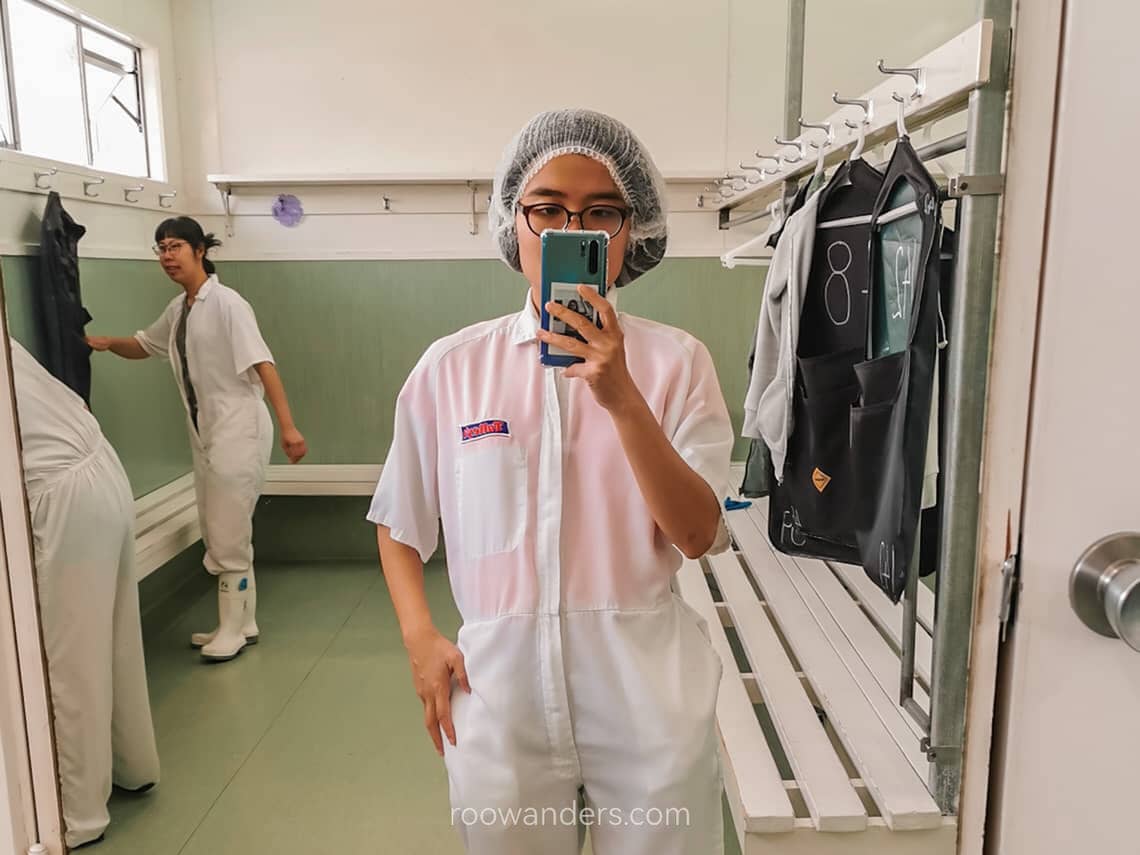
New Zealand Working Holiday Job #2: Mussel Opener
A short stint as a mussel opener opened my eyes (and pores) to life as a worker in a seafood factory.
Spoiler: It was not a fun job – in fact, this job ranks at the bottom of the 14 roles I have tried in NZ.
But it was enlightening and made me appreciate the work that goes into a packet of frozen half-shell green-lipped mussels in New Zealand. A pack costs SGD 17/ 900 g in Singapore or NZD 16/ kg in New Zealand (prices in Dec 2022). Because who would have had this rare opportunity to glimpse and experience life in a food processing factory?
Recap of my NZWH story thus far: Having travelled around New Zealand for three months from the end Dec 2019 to Feb 2020, I progressed from being unemployed in Queenstown to a plastic packer in Christchurch. As Singaporeans on the Working Holiday Visa had only six months (now extended to 1 year) in New Zealand, I moved to Motueka for the apple season in early Feb. Before the start of the season, however, I spent my first two weeks as a mussel opener.
You can read more about how I applied for the Working Holiday Visa here. I’ve compiled the most important info you need to know and will regularly update that post when new info pops up. Locate everything about New Zealand here.
I did this job in Feb 2020. This post may be updated periodically.
The Green-Lipped Mussel
The green-lipped mussel, named for its green edges, is native to NZ. Hence it is also known as the New Zealand mussel or the trademark Greenshell™ mussel. The Maori call them kuku or kūtai. Read more about the mussel life cycle and harvest on Niwa.

The mussels are grown and farmed all year round. I remember the mussel opening season starts in September and dwindles sometime around June-July when the peak Hoki season starts. Hoki is a white fish endemic to the Southern Hemisphere, and you can get them in frozen fillets from the supermarket.
Locations
There are two major seafood processing factories in New Zealand: Sealord and Talley’s. Both are coincidentally in the Tasman Nelson region. Talley’s is in Motueka, and Sealord is at Nelson – less than an hour’s journey in between. Talley’s have operations in Havelock and Blenheim for mussels too.
Talley’s does not just do seafood processing. It has other business ventures in vegetable processing and ice cream production, which means you can enjoy discounts for buying its brands in the factories.
Application
For my short work stint, I went with Talley’s in Motueka. Talley’s was constantly on the lookout for short-term staff in the summer of 2019/20, as most workers were (1) not able to persevere, or (2) went for other more lucrative seasonal roles.
According to others who were once mussel openers, Talley’s would often try to accommodate, rather than let go of their less productive staff. Those who cannot be fast openers move to other roles. A friend who does weight-lift shifted to packaging, where he enjoyed himself tremendously by lifting heavy boxes in the chiller room every day. Another friend became a box opener. Another does quality checks.

I went with a friend during their working hours for our application. Be ready with your passports! We filled in our details and had our visas checked before receiving a thick envelope containing the contract and brochures. In hindsight, that is a lot of money spent on producing printed materials for short-term staff, but I digressed.
Working Hours
You could choose to work the morning shift (6 am – 2 pm) or the evening shift (3 pm – 11 pm). Since waking up before 5 am to get ready for a job at 6 am sounds extremely tiring, I went with the evening shift.
As with all jobs in New Zealand, we had two paid 15-minute breaks, or ‘smoko’. During smoko, staff would walk from the processing room to the canteen, which was quite a distance. The bell would ring again after 15 mins, and all must gear up and be ready to start work within 5 mins.
The canteen sells discounted pies and drinks. Coffee and tea are complimentary.
Tapping In and Out
To track our attendance, there is a login system by the canteen. You must scan your fingerprints before work starts or risk being late. I remember every minute late was a 15 mins deduction from the salary, but it may be capped till 15 mins for the first 15 mins, and so on.
Logging out does not matter as long as it is not before work ends. You must log out before leaving the compound. Sometimes, as with all factory lines, there is a malfunction, and we get to leave slightly earlier.
Mussel Opener Trainee
On our first day of work, we were given individual pairs of white gumboots and white overalls. The overalls go to the laundry basket at the end of the day, while the boots, tagged with our names, go into the boots room.
We left our packed meals/ snacks in one of the many cabinets in the canteen and had our fingerprints scanned into the system.

Personal Protective Equipment
As with all food processing factories, sanitation and hygiene are critical. We had to put on hair nets and gloves. Before the gloves, we had to wash our hands with soap, followed by a squirt of sanitiser. Those with facial hair have to wear beard nets. Watches and jewellery such as bracelets, rings (unless a simple wedding band) and earrings are strictly forbidden.
For the personal protective equipment (PPE), each worker has to put on a disposable plastic apron like those you see in the butchery. We wear the workman’s cotton gloves over the thin surgical gloves. A pair of thick rubber blue gloves similar to those used for dishwashing goes over the cotton one. So that’s three pairs of gloves.
Training Schedule
Before entering the processing room, each of us had to put on an earmuff. The moving metal pieces in the room can be very noisy.
My friend and I spent the first half of our shift learning the technique outside the processing room. A senior staff member gave each of us a shucking knife marked with our initials. She then taught us the pointers to be efficient half-shell shuckers.
We spent the second half of our shift in the processing room practising our newly learnt skill in front of a huge conveyor belt of moving mussel mountains.

Mussel Conveyor Belt
Standing in front of the mussel conveyor belt is like sitting behind the sushi conveyor belt.
Rather than having plates of yummy sushi making their rounds around the belt, we have mountains of fishy blanched mussels.
A huge tank of raw mussels empties into a huge pot in the boiler room. The steamy blanched mussels then move out of the room via the belt and into our territory.
The fastest openers are arranged immediately beside the boiler room based on their opening speed. This ranking changes every day and defines their standing positions. We get to find out our new standing positions from the PPE/ sanitation room before entering the belt room.
The fastest openers get to grab the best mussels to open. Newcomers or noobs like us get to stand close to the boiler room too, but in the opposite direction of the belt, i.e. we stand opposite to the fastest performers who can open two mussels in one go.
I’m not sure if this placement stresses or energises the newcomers. For me, the placement distracted me from work as the pros were just too impressive to miss. Some seemed to have developed a dance routine to facilitate their speed. Needless to say, I imitated the pros, but nothing good came of it.
Mussel Records
Our position of the day on the belt is logged in the system, and we can check our progress throughout the day from an ingenious app. The app even compared the weight of the mussels you have opened to random things like monkeys.

The half-shell mussels we opened fall into a chute that delivers to the quality assurance (QA) team. As the mussel falls through the chute, a sensor detects the activity. The other empty shell goes to the chute collecting waste.
The role of the QA team is to scan through mussels that have been poked or sliced. That means the whole team, including the pros, gets a telling at the end of the day if there are many defects. I suppose the pros are used to that since new noobs come in every day to destroy.
Mussel Opening Standards
From what I learnt, a noob must progress to hit the minimum of 8000 mussels per shift within the probation period of three weeks. That is the contract rate as a mussel opener, and what the pros are achieving every day.
For pros, some of them go beyond 8000 to be in the 10,000 mark per shift. That makes it 1000 mussels/ hour or 17 mussels/ min. My high score before I left was 4000, with a speed of 516 mussels per hour (mph – lol), and that score was not easy to reach.
After three days of work, the senior staff may check on your progress and try to improve your speed. The staff will continue to check on your progress every three days or so to make sure you are on track to reach the 8000 mark by Week 3. Failure to do so usually meant moving out of the role as mussel opener, but most workers left before the third week due to reasons I’d mention below.


End of Shift
At the end of the shift, we returned the gumboots to the boots room and our soiled gloves and overalls to the laundry room.
Along the way across the canteen, we would scan out of attendance. Some may head over to the shower rooms to clean up.
The Joys of Mussel Opening
If you discover the trick to open two mussels within three seconds without any pain, then you will earn a lot.
For those looking for more hours and pay, you can sign up to clean the belt between shifts. Working overtime pays well, though the downside is you leave work much later than others. For the evening shift when work ends at 11 pm, those who do cleanup could end at 2 am. There’s not much OT to do for the morning shift when there’s only an hour buffer in between shifts.
I like that the company has shower rooms for workers to wash up before leaving. You would not want to fill your car with mussel aroma.
The shower water is super warm, which I greatly appreciate. The downside is you will be sharing the water pressure with others. Remember to bring along your toiletries and a hair dryer!
The Woes of Mussel Opening
- Boredom. You’re there to open mussels, and that’s it. If you want some music, prepare to spend over NZD 100 to buy a pair of 3M BlueTooth earmuffs. Maybe the pros have their playlists to hit the beats.
- Repetition. Excessive repetitive action can injure the body. In this case, the strain would be on the delicate wrist. I’ve heard someone requiring acupuncture to treat the strain. For me, it was at least a week of rest, after two weeks’ worth of shifts. But if you found the right way of opening like the pros, then it does not matter.
- Stench. Some guys left within three days because they cannot stand the fishy stench. The fishy notes penetrate through the PPE and stick to your innerwear and hair. To combat this problem, I apply peppermint oil over my nose in the toilet before going to the belt.
- Motion sickness. Staring at the fast-moving mussel mountains may trigger motion sickness, as my friend complained.
- Standing for long hours. At least the platform is adjustable for your height for better ergonomics.
- Warm working conditions. The closer you are to the boiler room, the warmer it is. Some guys told me they wore only boxers underneath their white overalls. At least everyone I see is wearing something under the sheer white overalls!

Closing Thoughts
So, are you game for some mussel opening?
For me, the two weeks spent by the large conveyor belt was an experience of a lifetime. Just as how I would not want to bungee jump again, I do not want to open mussels non-stop either.
Mussel opening can be lucrative if you are good at it. I know a few ex-working holidaymakers who negotiated for sponsorships from Talley’s and are now living in New Zealand. Some worked their way towards residency through mussel opening. My host in Motueka earned a living from opening mussels and has three houses under her name! Wow!
Post mussel opening, I had a short stint as a pear packer that coincided with the first covid case in New Zealand. I moved on to become an apple packer, which lasted for the entire lockdown and harvest season. You can read more about my experiences, tips and guides in New Zealand while on the Working Holiday Visa on this page!
Till then, stay safe!







